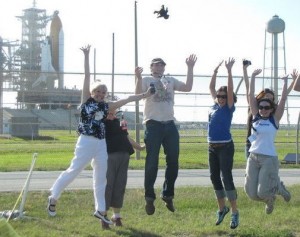
I am a huge NASA fan. I have been for as long as I can remember. Perhaps it’s a byproduct of growing up in Florida, or the fact that my first visit to Kennedy Space Center was when I was 20 months old. Regardless of why, I am a huge NASA fan.
NASA Tweetups
Even before I became a teacher, I knew there were a lot of opportunities for educators with NASA. However, it wasn’t until I started getting active in Twitter that I really saw how involved with the public NASA is. NASA hosted it’s first “tweetup”, a gathering of twitter users, on January 21, 2009 at the Jet Propulsion Laboratory. Since then, NASA has continued to support tweetups including two launch tweetups (STS-129 and STS-132) as well as tweetups at NASA headquarters in Washington, D.C., Johnson Space Center in Houston, TX, on the National Mall in Washington, D.C. for Earth Day, and as part of World Science Fest in New York City.
I had the distinct privilege of being a part of two of these events in person. Both I would call once in a lifetime experiences. I doubt I will ever have the opportunity to do things like this again. But then again, I never thought I would have a chance to do anything like this in the first place – so who knows!
In February of this year, I traveled to Houston, TX for the first NASA tweetup that was held at Johnson Space Center. It was a fabulous day. We began with a welcome session and Q&A with astronaut Bobby Satcher. We even had a recorded message from three of the ISS station crew members! Then, we began our tours visiting the Neutral Buoyancy Lab, the Space Vehicle Mockup Facility, the shuttle Mission Control Center, and the ISS Mission Control Center. This was during the mission of STS-130, and we were able to watch both the shuttle wake up from the shuttle MCC, and President Obama’s conference call to the shuttle and station crews from the ISS MCC! It was incredible!
Here is my photo album on Flickr from this event. (Note I do have more photos – just not uploaded yet!)
Then in May, I was chosen to be a part of the STS-132 launch tweetup at Kennedy Space Center. This was the second launch tweetup and included 150 people. I wrote a lot about it on my class blog. I used my blog and Twitter to stay connected with my classes in GA while I was experiencing the shuttle launch in FL. My students have a great appreciation for NASA and the shuttle program specifically because of it. Here is my Flickr set from that event.
If you are interested in all of the ways NASA is involved in social media, you can visit the NASA Connect page. If you are an educator not on Twitter yet, the NASA opportunities alone are worth the time investment!
Educator Resources
NASA has a plethora of educator resources. It’s easy to miss some of the great opportunities that they have available because there is so much information. The NASA Education page is a great place to start. You can find even more information from the Educator Resource Network Field Centers and State Centers. Take a look, and you’ll probably find there is a center not too far from you.
I also recommend signing up for the email list of NASA Education programs. You’ll receive emails a few times a week about all sorts of programs for k12 students through to post-doc. I find it’s the easiest way to stay on top of all of the exciting NASA opportunities that I can incorporate in my classroom.
NASA Explorer Schools Project
You have probably heard about NASA Explorer Schools before. NASA has revamped this program, and it will be relaunching on September 1st. It’s open to classrooms in grades 4-12. What’s unique about this relaunch is that it has been opened up to a larger audience. If you are interested in more information or registering for the orientation to be a part of this project, please go to the NASA Explorer Schools Project page.
NASA Electronic Professional Development Network
NASA has partnered with Georgia Tech to provide professional development opportunities to teachers. These are online courses in a variety of subject areas. They will soon be adding self-paced programs in other areas. Be sure to check it out periodically, as application windows open and close. (Right now the course Using Robotics to Enhance STEM Learning is open for applications.) Be sure to check out the NASA Electronic Professional Development Network site soon! By the way, did I mention that these courses are free and you should be able to talk to your school or district about receiving professional development credit for them?
I hope this gives you some information to help you get started in finding NASA materials to use in your classroom. NASA caters to all curriculum areas – not just science, math, technology, and engineering. I will also be sure to share new opportunities as I run across them. NASA is an amazing organization, and they can help make your classroom be out of this world!
1 comment